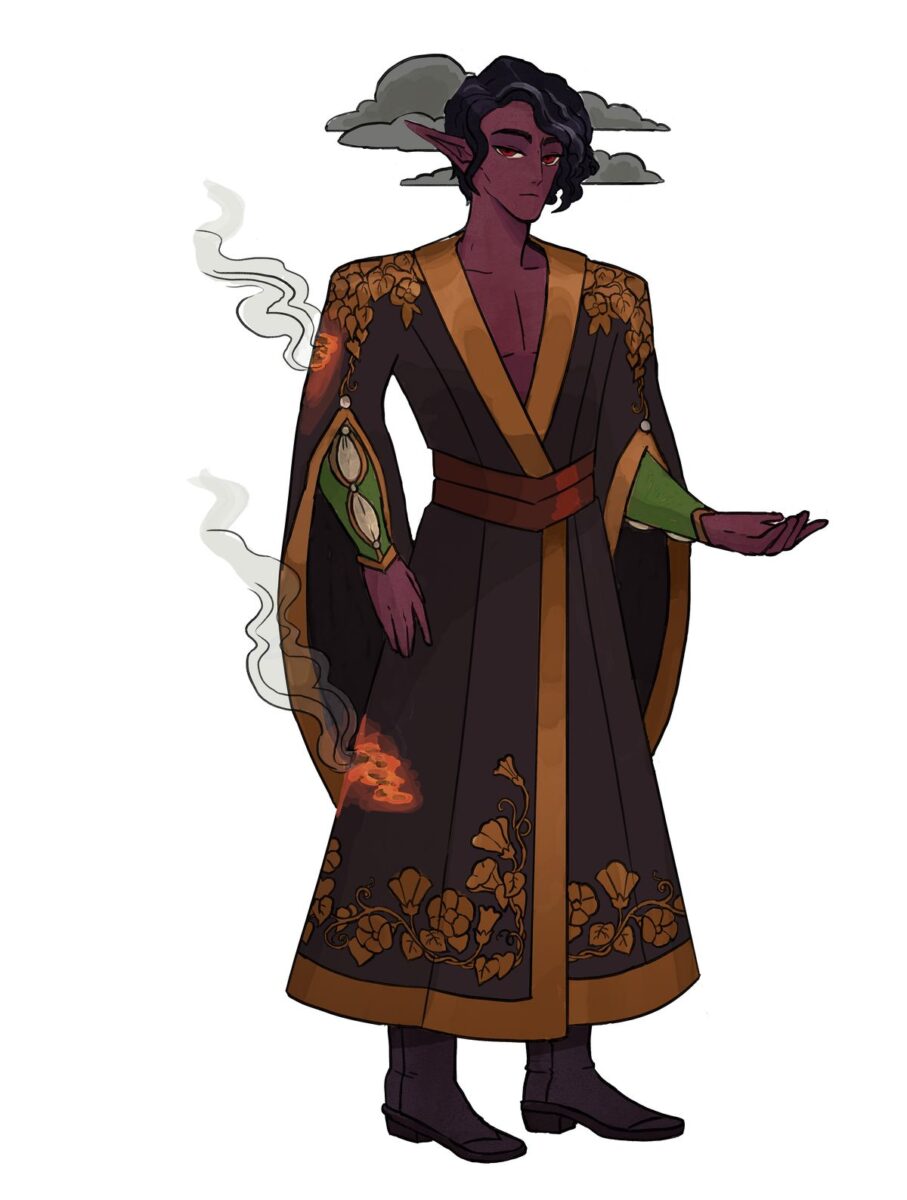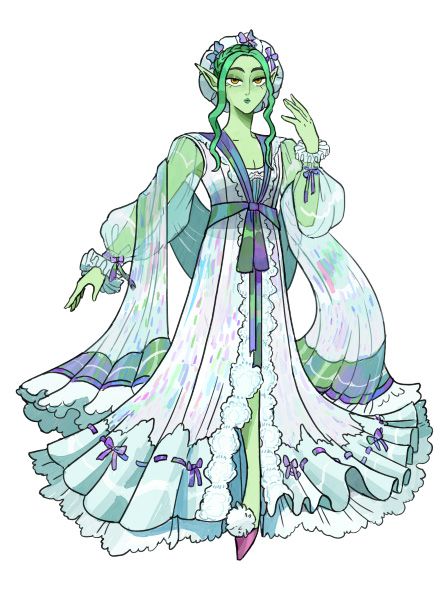Move over, Bridgerton. So long, Sanditon. My new favorite Regency-inspired show is Dimension 20’s A Court of Fey & Flowers. As a scholar of both 18th-century fiction and actual play, I’m telling everyone I know to watch this creative new spin on both Austen and actual play. In a time of an overabundance of Austen adaptation retreads, it’s refreshing to see a show playing with the much broader palette actually contained within Austen’s work — including her influences and the wider world she inhabited.
For those unfamiliar with the British Regency (1811-20), let’s first set the global scene. It was a time of great change. Revolutions had just happened — in the United States, France, and Haiti — and were looming on the horizon all across Europe. The powerful went cottagecore, rejecting hair powder, heavy makeup, conical corsets, and wide panniers for a few years of relative freedom before the coming backlash of Victorian hoops and bustles. Of course, the aesthetics of the Regency have their own grim origins. Filmy Empire-waist gowns were made from cotton derived from enslaved plantation labor and silks acquired by imperial conquest. Real-life tea tables were political battlegrounds as abolitionists avoided serving “blood sugar.” As Austen grew up, the fashion for sentimental, epistolary novels waned as thrilling Gothic tales, progressive political novels, and reactionary conservative fiction all surged onto bookshelves.
There’s honestly quite a lot for creatives to work with from this period, but much of it is neglected. That’s changing as more creators have tried to reflect the true diversity of the period, from Amma Asante’s 2013 biopic of real-life multiracial heiress Dido Elizabeth Belle to Austen’s Caribbean heiress Miss Lambe in Sanditon. Journalist Bianca Hernandez-Knight writes that majority-white audiences, influenced by the tradition of Regency romances started with Georgette Heyer in the mid-20th century, have pushed back, ignoring the long presence of Black and brown people in Britain dating back to antiquity. But, as writer Amanda-Rae Prescott argues, inclusive period productions are here to stay.
[embedded content]
And yet, even those of us most excited about the Bridgerton moment we find ourselves currently in have reservations: As scholar Patricia A. Matthew argues, there are complications in placing even positive fantasies in real historical settings. “I don’t really know what ‘right’ looks like,” she noted in Los Angeles Review of Books, “for Black characters in an England that in 1813 had abolished the slave trade but not slavery.” Tabletop creators have been exploring that ambivalence for years now. Vee Hendro and Hayley Gordon’s Good Society, the Austen-inspired RPG A Court of Fey & Flowers draws its mechanics from, wrestled with how to play with history the same year Bridgerton was greenlit. Hendro and Gordon’s solution leaves a lot up to players: During session 0, participants must choose whether to play in a historically accurate patriarchy, a gender-flipped matriarchy, or a more egalitarian world. At the same time, Good Society also informs its players — erroneously, I might add — that Austen’s work wasn’t about race, functionally banning it from play. The intentions of this are excellent; like Bridgerton and other inclusive productions, Good Society tries to create a space for everyone at the table. But, as designer Mark Diaz Truman observed in conversation with the designers on their Storybrewers blog, it also implies players must disconnect from their real-world identity to enter the game’s fiction. A healthy debate about how to adapt historical material ensued within the tabletop design space following its release, one that continues even now.

A Court of Fey & Flowers’ move to combine D&D with Good Society solves that conflict by disconnecting the Regency mechanics from real-world history. Its players aren’t historical figures, but instead are fanciful creatures from another plane of existence entirely. That doesn’t mean the campaign avoids the realities of power — it’s still Dimension 20 and it’s Aabria Iyengar, two brands known for challenging and progressive storylines. We’re introduced early on to court conflicts and hints that there are fey excluded from the pleasures of the Bloom. Reputation is everything, and we see its sway as those with higher reputation literally have mechanical advantages over those “below” them. Like real reputation, it’s not what’s in the players’ control, but what is publicly seen or believed about you. Brennan Lee Mulligan’s Captain K.P. Hob is keenly aware of this as he tries to paradoxically embody the chaotic values of the Goblin Court with military precision and dignity.
Several other players have also cited “repression” as key to their character creation. Omar Najam’s “constantly smoldering” secret-dork Andhera comes from a fascination with the “ghosts of tropes” — citing not only Austen but later 1840s novelist Emily Brontë, author of Wuthering Heights. Combining Batman-like brooding with “first day of school” energy, Najam reverse-engineered a new reading of Austen’s Darcy, often thought of as one of the “broody boys” but in the novel is, like Andhera, thrust into responsibility far too young.


Good Society’s secrets and rumor mechanics shine thanks to Dimension 20’s preseason preparation. Players know the rumors created in session 0, but don’t know which are true until play makes them true — or makes them vanish. So far, Surena Marie’s Gwyndolin Thistle-Hop is a font of secrets, and I initially tagged her as a modern Jane Fairfax. Like the secondary character in Austen’s Emma, Gwyn is built on every trope of perfect heroine-hood: naive, “charm personified,” and the center of a mystery. Her character art is even an 18th-century-inspired throwback, dressed in wide pannier hoops and lots of ruffles. In Austen’s novel, Jane’s secret is revealed near the end, but modern audiences — and players — are far more suspicious, so early on we see that Gwyn is really Binx Choppley, the sole survivor of the Court of Craft. It seems that is only the first of many revelations to come. Binx resembles a kind of Regency character we don’t often see in modern adaptations, the outspoken female revolutionary — hopefully more triumphant than her 1790s siblings.

Oscar Montoya’s Delloso de la Rue also gives us a taste of another group of oft-forgotten Regency characters: dandies, beaus, macaronis, mollies, and binary-fluting celebrities like Anne “Gentleman Jack” Lister, celebrity spinsters the Ladies of Llangollen, and former French diplomat the Chevalière d’Eon as well as Masters of Ceremonies and arbiters of fashion like Beau Brummell.
So far we’re on a largely pacifist run for this campaign, which focuses less on violence than typical D&D — even a serious duel ends in applause rather than lasting physical damage. Iyengar and her cast are exploring the soft power in what professorial nerds like me call the “marriage plot”: a genre that exploded in the 18th century as the legal and social rules rapidly changed. Heroes and heroines tried to navigate a world divided between the old concept of marriage as alliance and the new idea of “companionate marriage” for love and friendship. We see this strongly in Lou Wilson’s and Emily Axford’s characters, cousins who are trying to do both. Their grandfather demands that they marry well by the end of this season — er, Bloom — while they bet Rue they can marry for love.
While Wilson reports that he simply Googled “most annoying characters in Austen” as character prep, Austen scholar Emily Kugler squealed in delight while we watched the premiere together. “They’re the Crawfords!” she shouted — that is, Henry and Mary Crawford, the sexy, inappropriate love interests of Austen’s Mansfield Park. Eighteenth-century readers would have called them rakes, bad boys who inspired debate: Did “reformed rakes make the best husbands” or were they, like real life rake Lord Byron, “mad, bad, and dangerous to know”? Rakes were secondary characters who came to bad ends; after flirting intensely with the protagonists, the Crawfords both make miserable, mercenary marriages. In the hands of master players Wilson and Axford, it seems inevitable we’ll see this script flipped.
And that’s what I’m most excited for: Regency characters that pop culture often overlooks, getting stories and endings the period couldn’t possibly imagine.












